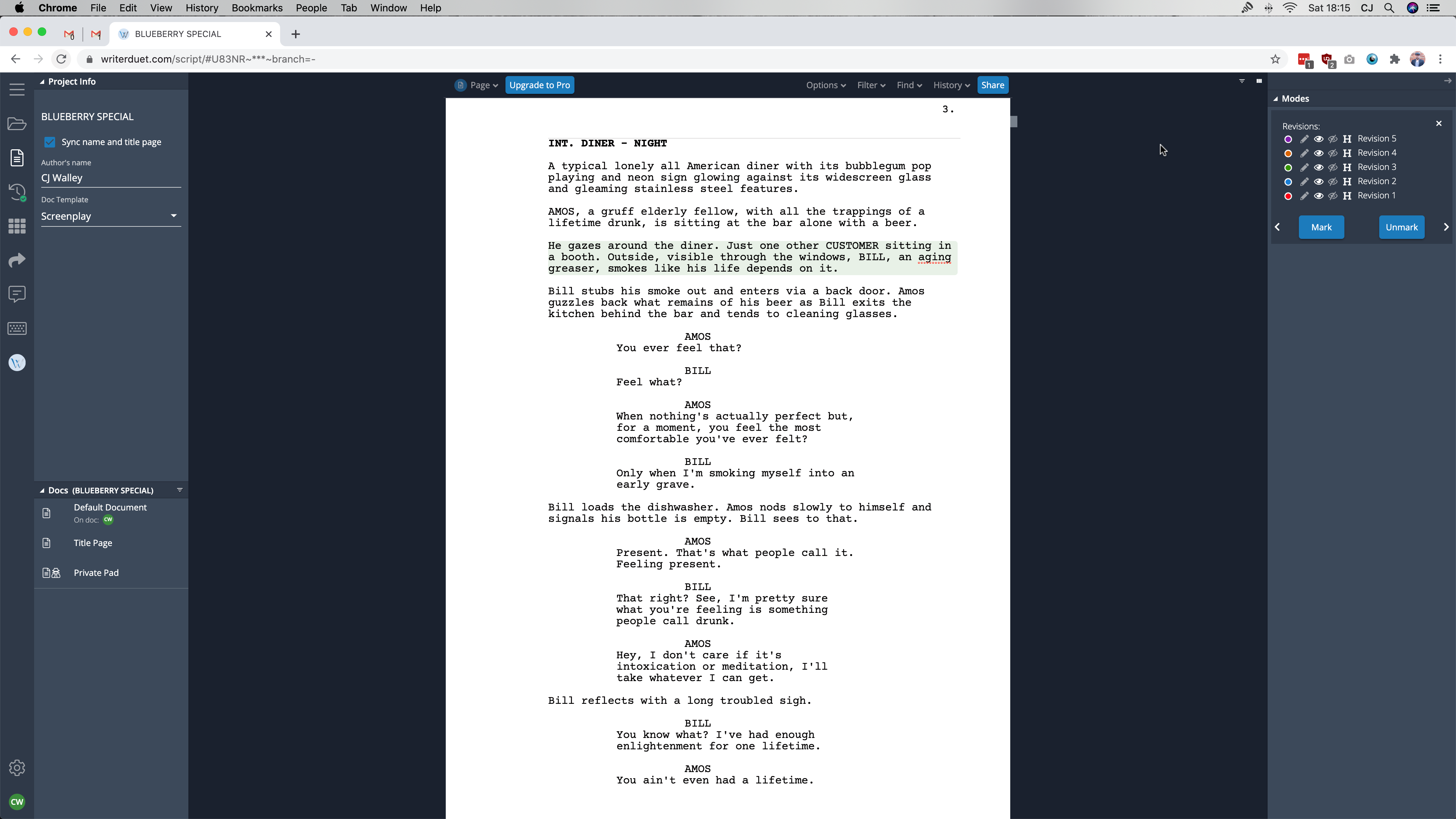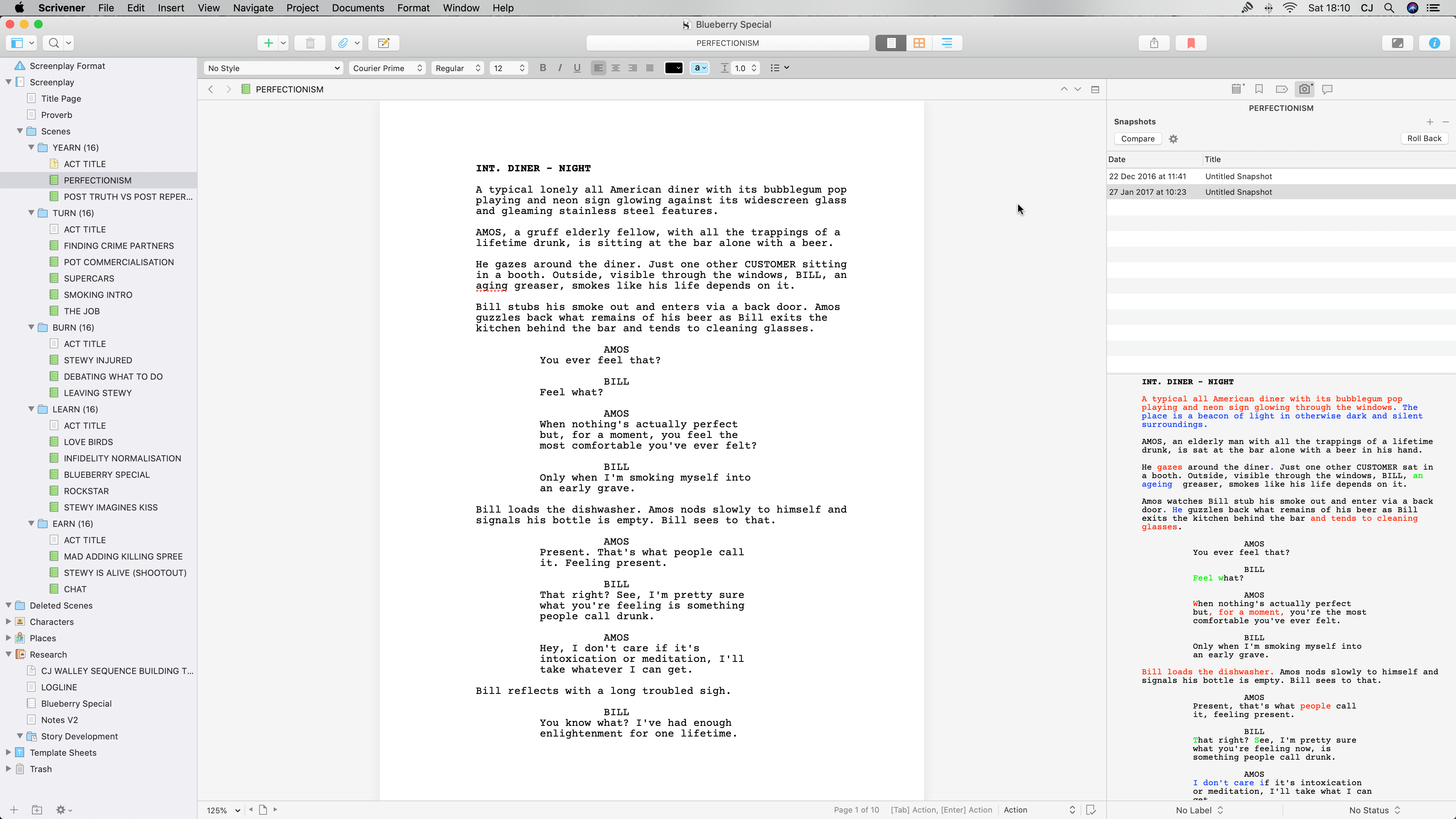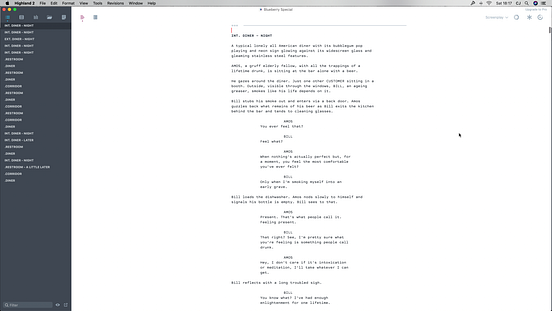Yes, we all know the rehearsed phrase by now, “Final Draft is the industry standard!”, an axiom it seems many screenwriters feel obliged to screech at anyone who dares ask what the best piece of software is to turn our day-dreaming into a full fleshed out, Hollywood ready, screenplay. However, as artists always looking to improve our craft, we owe it to ourselves to explore the other options out there.
I’m presenting this as alternatives to Final Draft and dismissing the notion that it’s an essential purchase to aspiring screenwriters but I want to establish the context here. Final Draft is an industry standard, that’s undeniable. You will find it in the writers room. You will find most producers use it. You will find most industry members assume you use it. But the industry standard side of Final Draft only really applies to the file format, the revision work-flow, and the various bits of software related to production that plug-in to it. When it comes to composing a screenplay (i.e just writing), there is no industry standard other than being able to output a correctly formatted pdf. Therefore, you should use what brings out the best in you as a writer just like a painter finding the right brushes or a musician selecting the right instrument. When it comes to collaboration however, you have little choice but to fall in line much like the average office worker needs to know how to use Microsoft Office or a graphic designer needs to be familiar with the Adobe Creative Suite. It’s important we separate composition from collaboration.
So, given that Final Draft itself is designed for composing screenplays and is so commonly used within the industry, why not just roll over and use it by default? Well, beside the hefty $250 price tag for what’s essentially a glorified text editor, it’s arguably a clunky composition tool with an ugly interface that lacks many useful story-writing features. Those that argue it’s the best screenwriting software option out there often do so because they simply haven’t tried the modern alternatives and feel a sense of exclusivity in using the same tools as their heroes. They want you to join the cult so the cult grows stronger. I’ve yet to see a single Final Draft advocate come up with a list of objective reasons why it’s better than the competition.
To be frank, if you aren’t at least having a casual look around at the alternatives to the most critical piece of software you’ll use as a writer, you are, as we say in the UK, “ being a bit of a muppet”.
The smart screenwriter in today’s age is always scanning the horizon looking for the best composing tool available while waiting to pull the trigger on Final Draft when the time’s right. Many professional screenwriters have a workflow where they compose in one program until they have a draft ready to share with producers and move across to Final Draft for subsequent revisions, scheduling, and production. That’s what this working screenwriter does and you know what? For that side of things, Final Draft works just fine.
I’ve been trying Final Draft alternatives for some time now and I want to bring your attention to three options I feel stand out above the rest for vastly different reasons.
Writer Duet
You are probably not surprised to see this listed and that’s significant. Writer Duet has gained remarkable traction over the past seven years and is by far the most common Final Draft alternative I see mentioned within communities. Built on the concept of working in the cloud and using browser based software (plus a mobile app), Writer Duet gives writers access to their working documents from any device at any time meaning you don’t need to concern yourself with storage or operating systems. In fact, Writer Duet can be run from something as cheap and simple as a $200 Chromebook, meaning you could jump in and start churning out professionally formatted screenplays on a brand new laptop for less than the regular cost of Final Draft.

It’s feature rich too with outlining and revision tools within a user interface that isn’t amazing, you are bound by the browser after all, but is highly customisable to suit your needs with numerous pre-configured setups. You can collapse and expand sections of script and go back and forth between drafts making your drafting and rewriting a hell of a lot easier.
Writer Duet also jumped in and embraced the gap were those writing in languages such as Mandarin were underserved, showing the developer’s willingness to be lead by the global writing community rather than serve LA based luddites still reeling from having to move away from mechanical typewriters. These developers are embracing their community rather than taking it for granted. That’s valuable.
Where Writer Duet really shines though is with collaboration. It’s cloud based nature lends itself to allowing other users to log in and work live on a document similar to Google apps, meaning you don’t need to send files back and forth to see and discuss changes. However, good luck finding many older industry members technically savvy enough to embrace that way of working and willing to change their ways, especially on something as precious as a production script.
When it comes to pricing, Writer Duet offers you the opportunity to write your first three scripts for free and then move on to a $5 per month “Plus” plan (if you buy an annual subscription). There’s fancier plans that come at a higher cost too for those on a more professional level and, if you catch them during one of their Reddit deals, you might be able to snap up a one off lifetime deal. Long story short, you’d have to subscribe to Writer Duet for over four years before it would cost more than Final Draft, assuming you refuse to ever upgrade the latter. You can also use choose to use its free cousin WriterSolo which is available as the same browser based interface or a downloadable app which lacks the cloud file system and instead saves directly to your computer.
Notable Writer Duet users include Christopher Ford who’s credited with Robot & Frank and Spider-Man: Homecoming. More information can be found out via www.writerduet.com where you can jump in and try the software right away.
Scrivener
Yeah, it’s got a name akin to a villain from a Dickens novel but it references something important that I’ll get to. Firstly, you should know Scrivener was developed by actual writers turned software engineers who wanted a program better orientated to story development. Scrivener is like the final boss of fictional writing software, loaded to the guns with features, and built around the concept of scrivens; individual sections of content.

By embracing the world of scrivens (scriven is a term for the act of writing), authors can break material up into as many sections as they like and treat each section as it’s own document with its own notes, meta-data, comments, and more. This means you can break down a story into acts, scenes, or even beats, and work on those parts in isolation. It gets better too. Need a document that lists all your characters? Just create a new scriven and keep it in your reference folder. Got a load of technical information you need to keep on file? Pop it in the research folder. It’s up to you and means you have one central file that contains everything you need.
Available on both Mac and PC, Scrivener is supposed to be a novel and technical document writing tool but the developers opened it up to script writing some time ago, bringing in a “script mode” option with a screenplay format compiler to output scenes into a professional looking pdf. To bottom line; you can use this story writing behemoth to write screenplays AND keep all your other associated documents on hand within the same project file.
The user interface is well, let’s just say “highly functional” but the full screen composition mode, while simple, is very pleasant to use compared to Final Draft. No, as a screenwriter, you’re not going to be using all of the features available but you are going to fall in love with things like snapshots which allows you to store and roll back to various revisions of any one scriven. Let’s say you want to see how you’d once drafted a single scene two years ago, you can do that, and you can easily roll back, run comparisons, or pull content back out. No more going through old files and scanning through old scripts to find that killer monologue you regretfully cut out.
By breaking things down and offering individual focus of specific script sections, a complex story becomes something much easier to handle while maintaining control and never feeling content gets lost in the process. Plus, there’s automatic backing up of documents and a free app allowing you to sync your work between desktop and mobile device (provided your cloud document provider is Dropbox. It sadly doesn’t work with iCloud).
Where Scrivener does struggle is with presenting the editing page exactly as it will appear in the output pdf and, by struggle, I mean completely fail. This makes trying to address things like orphans, something we script writers face constantly, a case of trial and error and can really affect how a script looks and how many pages long it is. Compare that to Final Draft which does show your script exactly how it will look when output, this can be frustrating and potentially time consuming if you care about it. Worse still, Scrivener can get a bit loosey-goosey with page breaks and inserting the correctly formatted (more)s and (cont)s without breaking up any dialogue blocks in the process.
Look, I produced screenplays with no nasty orphans that hit a specific page count perfectly with the page break issues present for years using Scrivener and still broke into the industry. It’s not that big of a problem if you’re prepared to spend a little more time polishing plus, if you do have Final Draft or one of the other two alternatives mentioned here, you can export your latest draft and do your polishing in those. It just makes sense to use the right software for the right parts of the process.
Notable Scrivener users include Niel Cross who wrote the BBC TV Series Luther and costs a mere $45 for a standard license. More information can be found at literatureandlatte.com where there’s also a free demo to download.
Highland 2
This one is a little bit of a curve ball but really focuses on the factor I want screenwriters to take note of — the importance of aesthetics in a tool meant for composing. Highland is so sleek and airy feeling it makes Final Draft feel like writing on a Casio calculator. It is offensively pretty in terms of its user interface and colour customisable to your tastes. It’s made by John August, the screenwriter behind Go, Big Fish, and Charlie and the Chocolate Factory so, if the actions of a top Hollywood screenwriter can’t convince you that you should take your composition tool seriously, I’m not sure what will. Plus, if you know John August, you’ll know he’s got a keen eye for please aesthetics, even going so far as to create the new screenwriting typeface Courier Prime.

Highland creates an environment that begs for you to write. Not only is the blank page inviting, it empowers you to produce prose by doing away with the tab key to switch between formatting elements and instead recognises what the writer is typing automatically via what it calls Live Margins. Start typing INT. or EXT. and it will default to slugline formatting. Put something in (brackets) and it will create a parenthetical. It sounds a little petty to care about this but we’re talking about minor actions the average screenwriter is having to do thousands of times a year.
There’s also some neat exclusive features aligned with the goal of producing content and evading procrastination. “Goals” allow you to set a word/page count and achieve milestones by meeting your target. “Sprint Mode” encourages you to set a time, hit a button, and get to work, your reward being a report on your progress at the end and the option to share a summary on Twitter. Great for those times you need to hold yourself accountable and motivate yourself through the grind of typing.
Highland is also built around an editor and preview mode. The former using a very clean typeface and lots of white space to compose and the latter showing how your script looks when traditionally formatted. It’s through this that you’ll realise just how ugly and uninviting a typical script looks. The editor view also allows you to place headings, synopsises, and notes directly into your prose while hiding them in preview mode and giving you the option to show them when you export to pdf. For those like me who prefer to outline their beats first, this is a great feature.
You can also use the navigator to pick up entire scenes and move them around and also move your notes and synopsises around within them plus there’s a revision mode pretty much identical to Final Draft which uses the familiar colour change and asterisk system to highlight what’s changed. However, you are going to have to import and export back and forth between the native .highland and .fdx format to collaborate with Final Draft users.
So, what’s the catch, you might be asking? Well, Highland 2 is currently only available for MacOS which means you need to invest in a machine just as sleek and sexy as the software to use it… unless you’re willing to build a hackintosh that is. Good news if you’ve already got a MacBook but certainly not a good enough reason to switch over if you haven’t. The editor also doesn’t quite perfectly show how your lines will break when exported to pdf and there’s no real snapshot/versioning system for scene drafts. Oh, and there isn’t an iOS app yet either so no jumping on your iPad to continue working.
Notable Highland 2 users include Phil Lord, writer of Spider-Man: Into the Spider-Verse, The Lego Movie, and 21 & 22 Jump Street. There is a free but somewhat limited Basic version (it watermarks your exported pdf files) which is good for trying it out but you really need to upgrade to pro for around $60 to get any real-world usability. You can get more information via quoteunquoteapps.com/highland-2/
To Conclude
When it comes to software, there has been no better time for screenwriters than right now with an abundance of Final Draft alternatives out there that are not only dramatically cheaper but have cleaner user interfaces that inspire you to write and offer unique features that make the process of story development and drafting easier to manage. The more competition out there, the better it is for us as consumers and the more likely we’ll find the right fit.
Just please remember that the best option, or combination of options, is highly subject to your needs and preferences at the current time. Maybe Writer Duet is perfect for you and a writing partner as you’re writing your first screenplay together and don’t want to install any software or spend any money. Perhaps a combination of Scrivener and Final Draft is perfect for your needs in terms of detailed story development and industry member collaboration. Maybe Highland 2 is the breath of fresh air you need as a seasoned writer who just wants to get their head down and type.
Of course, there are other options available for your consideration and I encourage you to check out the list I keep updated at cjwalley.com/turn-and-burn/screenwriting-software/

